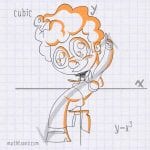Fun with Functions

According to the NCTM standards for school mathematics in grades 9 through 12, there is a significant emphasis on understanding the patterns of relations and functions requiring the homeschool student to “interpret representations of functions in two variables.” And if that last sentence doesn’t strike genuine fear in your heart, you are one very rare and brave home schooler!
For many homeschool parents, the weighty responsibility of choosing and implementing middle and high school math curricula is one of their most daunting challenges. In my career as a private math tutor, I’ve experienced frantic emergency calls from homeschooling parents who have hit that point in their child’s math studies when they have to bring in “the professional.” I’m always more than happy to oblige because the best part about working with the homeschool student is that I have flexibility when interpreting “representations of functions in two variables.” And I’m willing to share some of these interpretations with you today!

Luckily, these relationships between x and y are drawn in much the same way that the initial pencil strokes for illustrations are drawn: with very simple and fluid “lines of motion.” If we consider the curved movement of a graph as something similar to the direction of motion of, say, a cartoon character, then we have the basis for a very fun way to remember the shapes of various mathematical functions and relations.
So I asked my friend and colleague, Jessika von Innerebner, to lend her wonderful artistic skills to help students remember the shapes of graphs by superimposing some illustrations of funky dance moves onto the functions you see sketched here. If you are looking to create an interesting middle or high school math lesson that encourages the memorization of the shapes of various graphs, experiment with having your student draw his or her own illustrations onto the graph of a linear, quadratic, cubic, trigonometric, statistical or any other type of mathematical function or relation. After all, a sine curve becomes significantly more memorable when a sea serpent is sketched over top of its periodic wave motion!
This “math and art” lesson could lead to many more explorations concerning “the art of memory”. Students can discover some of the ways in which successful scientists and mathematicians use interesting visuals to help them remember the myriad facts and methods within their particular disciplines (called “mnemonics”). When we encourage students to create their own individual and unique ways to remember difficult subject matter, we help them understand that learning and remembering tough concepts can be truly enjoyable. Print out some function graphs, bring out the art supplies and encourage your student to create fun illustrations that can help with remembering various graph shapes. Everybody dance now!
Kristin Garn (aka “The Dreaded Supertutor”) is the director of Mathtoons Media, which is currently creating digital learning products designed to deliver fun ways to practice upper level math concepts like algebra, trig and calculus. For over 20 years, Kristin has taught math and science at the high school and university levels. She blogs at www.mathtoons.com and can also be followed on Twitter and Facebook.









This is one of the best ideas I’ve seen. My 9th grader loves to doodle so now she can doodle with a purpose. Thank you.
Kathryn, we’re glad this article helped you! I have a 10th grader, and I think this will be good for him too.